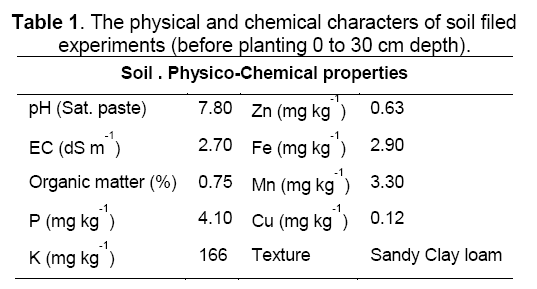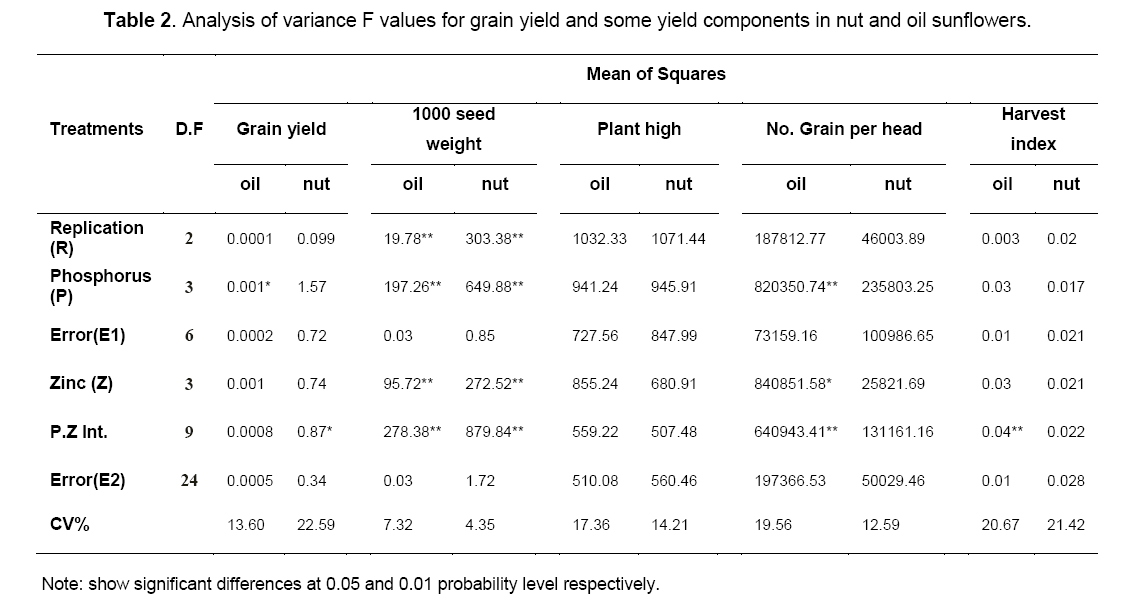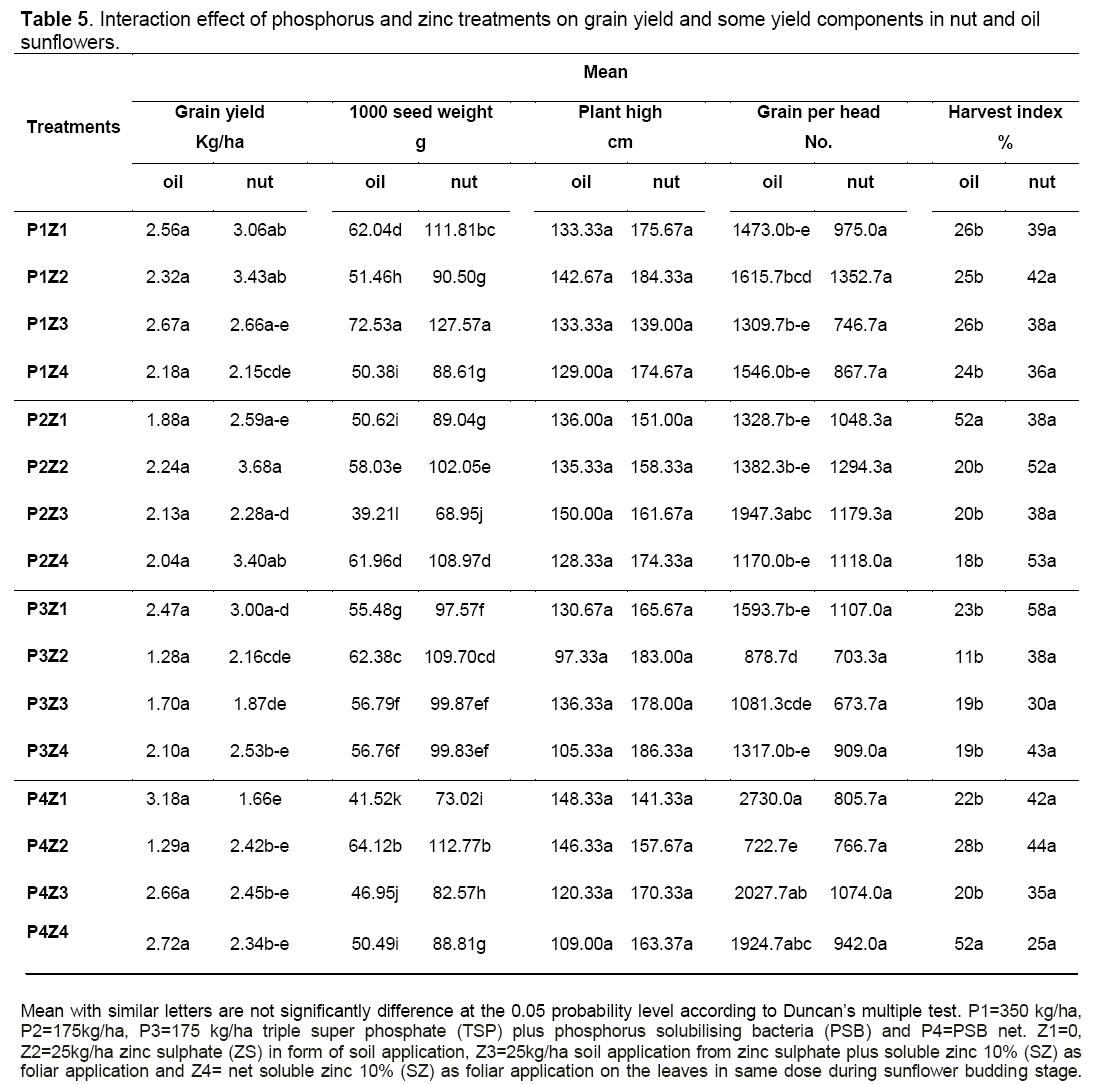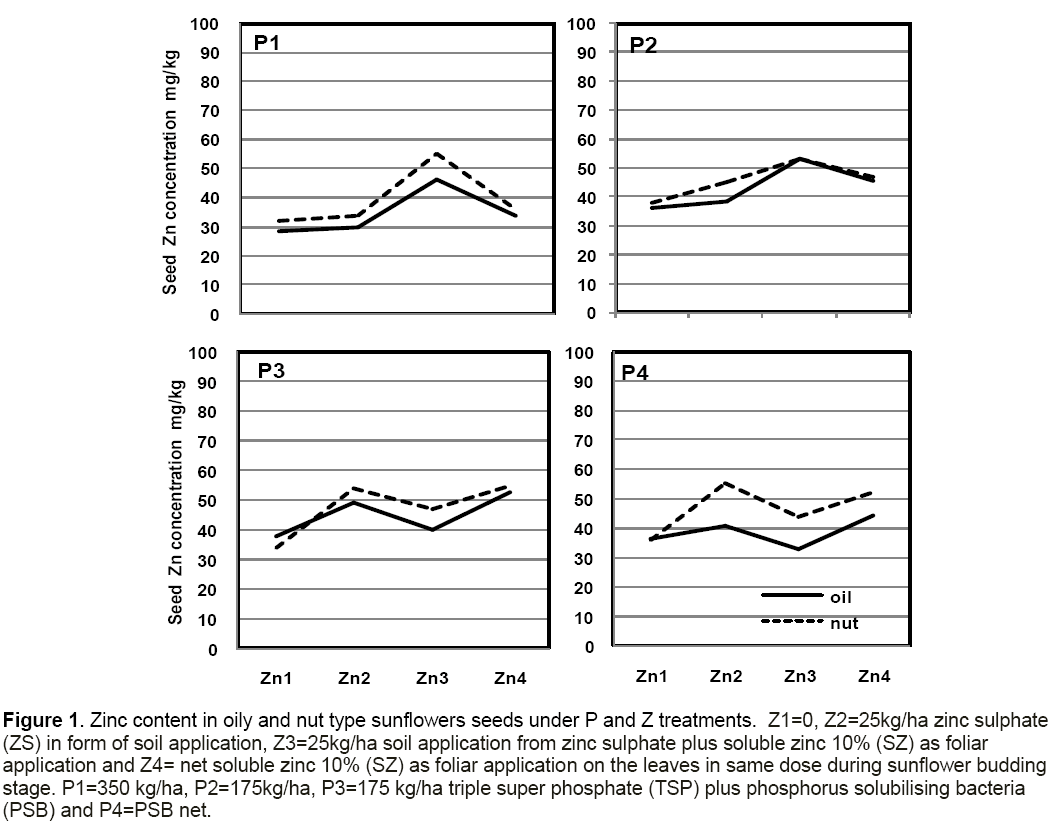Response of Nut and Oilseed Sunflower to Different Sources and Levels of Phosphate and Zinc Nutrition
Hamid Madani
Hamid Madani*
Associate professor in crop physiology,Department of Agronomy and plant breeding,Arak Branch,Islamic Azad University,Arak,Iran
- Corresponding Author:
- Hamid Madani
Associate professor in crop physiology
Department of Agronomy and plant breeding
Arak Branch,Islamic Azad University,Arak,Iran
Tel: +98(0)8614132153
Fax: +98(0)4132153
E-mail: h-madani@iau-arak.ac.ir
Abstract
In order to comparing some responses of nut and oil sunflowers types (Helianthus annus L.) current experiments were conducted at Agricultural Research Centre, Islamic Azad University Arak, Iran during 2011. The treatments were different sources and levels of phosphorus and zinc fertilizer under field condition. Four levels for phosphorus included 350, 175, 175 kg/ha triple super phosphate (TSP) plus 100g/ha phosphorus solublizing bacteria (PSB) and PSB alone. Four levels of Zinc also were 0, 25 kg/ha soil application from zinc sulphate (ZS), 25 kg/ha soil application from zinc sulphate plus soluble zinc 10% (SZ) foliar application and soluble zinc 10% (SZ) as foliar application were applied. The results showed in oil type sunflower interaction difference between grain yields was not significant difference. The lowest grain yield in oil type sunflower was 1.28 and 1.29 t/ha by utilization of 175kg/ha TSP + 100 g/ha PSB plus 25 kg/ha ZS in form of soil application and 100 g/ha PSB simultaneously without statistically difference. Field consumption of 350 kg/ha triple super phosphate and soluble zinc foliar application caused significant increase in seeds weight for oil and nut sunflowers types. The highest sunflower grains number in heads was 2730 kernels by obtained in treatment that received phosphorus from PSB alone. The consequences of this study propose that soil application of zinc sulphate may increase grain yield and zinc content in sunflower grain under Arak soil conditions.
Keywords
Sunflower,Zinc,phosphorus,nut seed,oil seed,Yield.
1. Introduction
Sunflower is from Mexico and Peru originally. People not only used the seeds as a food and an oil source,but also used the flowers. The Spanish explorers brought sunflowers back to Europe,and after being first grown in Spain,they were subsequently introduced to other neighboring countries. Currently,sunflower oil is one of the most popular oils in the world. Today,the leading commercial producers of sunflower seeds include the Russian Federation,Peru,Argentina,Spain,France,China and also Iran. Sunflower seeds are a very good source of vitamin E. In addition,sunflower seeds are a good source of manganese,magnesium,copper,selenium,phosphorus,vitamin B1,B6 and folate but not zinc. Thus,Sunflower (Helianthus annus L.) makes one of the most important sources of high quality edible oil has been identified to be a potential oilseed crop [16].
The sunflower seed is the fruit of the sunflower. The term "sunflower seed" is actually a misnomer when applied to the seed in its pericarp. Botanically speaking,it is more properly referred to as an achene. In addition,Iranian young people often like to eat roasted sunflower seed as snake more than others. In alkaline soils Micro-nutrient deficiencies in plants are becoming Increasing trends. It is the main reason for low levels of micronutrients especially Zinc (Zn) in local human food [2,26]. Zinc deficiency in soils is common in arid and semi-arid regions. Little or no use of Zn fertilizers along with unbalanced fertilization further aggravated Zn deficiency in soils resulting lower Zn contents in grains [27]. Supply best possible quantity of mineral nutrients and using balanced macro- and micronutrient doses to growing crop plants is one way to improve crop yields [5]. Mineral nutrients possess several roles in formation,partitioning and utilization of photosynthesis Faizus and Shahedur.,[11,13].
Therefore,mineral nutrient deficiencies significantly harm production of dry matter and its partitioning between the plant organs [24,8]. Deficiencies of mineral nutrients severely limit flower initiation and development and viability of pollen grains [23]. The concentration of mineral nutrients in the soil solution,i.e. the available nutrient concentration,varies over a wide range,depending on many factors such as pH,soil organic matter and fertilizer application [11]. High pH and low organic matter characterize soils of arid and semiarid areas. Such properties reduce the availability of the mineral nutrients to crop plants. The sunflower plant deficiency of any micronutrient negatively affects plant growth,development and finally yields,thus minimizes the usefulness of other agricultural inputs including N,P and K fertilizer,the efficiency of which can substantially be increased by application of zinc [6]. A significant increase in grain yield,protein and oil contents of sunflower due to zinc application has been reported [9]. Foliar applications of micronutrients are mainly recommended. However,micronutrients application through irrigation/soil is also nowadays applied [4]. Zinc had effect in protein synthesis,gene regulation,DNA transcription,protection cells from oxidative damage.
Zinc deficiency reduces net photosynthesis,internodal length of stem,increasing chlorosis and necrotic spots in the leaves and severely reduce seed yield [1]. Sankaran,et al. [22] concluded that the highest seed yield (1716 kg/ha),oil percentage (36%),oil yield (616 kg/ha),protein percentage (16.6%) and protein yield (284.8kg/ha) obtained by spraying sunflower leaves with zinc concentration of 0.5 ppm. Praksh and Halaswamy (2004),found that spraying plant leaves with 0.3 ZnSo4 gave a high values of head diameter (20 cm),no. of seeds per head,1000 seed weight (62.2gm) and seed yield (1600 kg/ha).
Gitte et al,,[7] indicated that adding 5.25 kg Zn/ha to the soil,produce maximum values of 1000 seed weight (65 gm),seed yield (3400 kg/ha) and oil percentage (41%). Marschner [12] reported that critical concentration of zinc in plant leaves ranged 15-20 mg/kg dry weight. The aim of the research was to determine the effect of zinc and phosphorus fertilizer on yield and its components of sunflower hybrids under the environmental conditions of AL-Quba district-Mosul.
2. Materials and Methods
The experiment was conducted during spring and autumn growing season of 2010 at Arak,Iran on a sandy loam soil having 0.08,4.1,166 and 0.63 ppm available N,P,K and Zn respectively (Table 1). The experiment was laid out according to the split plot experiment biased on Randomized Completely Block Design with three replications. A net plot area was 18 m2 (3.0m in 6.0m). Phosphorus fertilizers were applied to the soil in form of triple super phosphate (TSP) with 48%P2O5 and Phosphor solublizing bacteria (PSB) a combination Pantoea agglomerans strains P5 and Pseudomonas putida strain P13). Zinc sulphate (ZnSO4.7H2O10%) was soil application and water soluble zinc (SZ) was foliar application type. The main plots were four levels of phosphorus application (350 kg/ha,175kg/ha,175 kg/ha triple super phosphate (TSP) plus phosphorus solublizing bacteria (PSB( and PSB net and sub plots were arranged for Zinc treatments in four levels too,(0,25kg/ha zinc sulphate (ZS) in form of soil application,25kg/ha soil application from zinc sulphate plus soluble zinc 10% (SZ) as foliar application and net soluble zinc 10% (SZ) as foliar application on the leaves in same dose during sunflower budding stage. Two hybrids of sunflowers (Zaria oily and Shamshiri nut) were sown at 7th June,harvested at 20th October for oil type and 25th October for nut type respectively. The distance between hills was 20 cm with 50 cm distant ridges to attain a plant density of 75000 plants per hectare. Nitrogen fertilizer was applied in the form of urea (46%N) by adding 150 kg/ha Urea in three time by equal doses,50 kg/ha with sowing and the remaining 50/ha kg 30 days after sowing and last part of urea before flowering stage. Potassium was applied by adding to the soil for 150 kg/ha potassium sulphates (48%K2O) as basic fertilizer. The first surface irrigation was applied immediately after sowing and after wards irrigation was scheduled at about 5 to 7 day's intervals. Before planting the soil samples were collected from 0-30cm depth and analyzed for physico-chemical characteristics (Table 1) according to the methods described by Ryan et al. [21].

Grain yield,1000 seed weight,plant height,head diameter and Zinc and phosphorus Concentration in Shoot were measured. The obtained data of both experiments were subjected to the analysis variance procedure and treatment means were compared to the Duncan multiple test,using SAS software individually and Microsoft Excel program.
3. Results
3.1 Grain Yield
Tables 3 and 4 showed the simple effect of phosphorus and zinc separately. In oil type sunflower the highest significant (P≤0.05) grain yield of 2.52 t/ha was obtained by application of 100 g/ha PSB in soil application form on sowing time. It for nut type was 3.68 t/ha in P2Z2 or application of 175 kg/ha superphosphate with 25 kg/ha zinc sulphate (Table 2). Confirming the results was by Rashid et al. [20] and El-Fouly et al. [4]. Non significant interaction difference between grain yields was observed in treatments for oil type sunflower. Table 5 showed the interaction effects of phosphorus and zinc. The lowest grain yield in oil type sunflower was 1.28 and 1.29 t/ha by P3Z2 and P4Z1 simultaneously. Therefore,this record for nut type sunflower was 1.66 t/ha by P4Z1. These results showed in both sunflower types the zinc application either in soil or foliar application could not increase grain yield without enough phosphorus nutrition levels. In other hand,soil application among of 0 to 25 kg/ha zinc sulphate alone or with PSB biofertilizer plus 175kg/ha superphosphate (P3) and PSB alone (P4) application had no significant difference in grain yield. Mirzapour and Khoshgoftar [14] found increase in seed yield of oily sunflower with 10 and 20 kg/ha zinc. This adequate amount of zinc and iron indicates the necessity of zinc and iron application to plants [12].



3.2 1000 Seed Weight
Results of analysis of variance showed the significant interaction effect between phosphorus and zinc application (P<0.01) on both sunflowers 1000 seed weights (Table 2). Utilization of 350kg/ha superphosphate compound and soluble zinc foliar application (P1Z3) caused to increase the weight of seeds in oil and nut types of sunflowers. The most weight of 1000 seeds by 72.53g in oil type and 127.57g in nut type were obtained from high phosphorus input and Zn spray or non zinc deficiency plots. This treatment (P1Z3) caused 54.48% and 54.49% increase in 1000-seed weight compared to low phosphate available and zinc foliar application (P4Z3) in oil and nut sunflower type simultaneously. The minimum 1000 seed weight in oil type sunflower (39.21g) and nut type sunflower (68.95g) belonged to P2Z3 (Table 5). The increase of 1000 seed weight due to P and Zn application might be due to their positive effects on assimilates translocation,activation of photosynthetic enzymes,chlorophyll formation and improvement of plant growth [15].

3.3 Plant Height
Data of plant height indicate that we did not see significant difference between highest and lowest plant height in both sunflower types (Table 2). Increase in shoot length was recorded in bread and durum wheat [2],safflower and sunflower [8] with zinc application. Our consequences show that in all probability the defined levels of P and Zn nutrition in present scientific report were not restrictive factor for significant changes in sunflowers plant high.
3.4 Numbers of grain per head
Consequences of analysis of variance for numbers of grain per head in oil and nut types of sunflower showed the significant interaction effect for phosphorus,zinc and also treatments interaction (P<0.01) in oil sunflower type. Nut sunflower had not significant changed in grains number per heads (Table 2). In oil type sunflower the highest grains number in heads by 2730 kernels was obtained in P4Z1 treatment that received phosphorus from PSB alone (Table 5). The lowest kernels in head were 722 grains number in heads that observed in P4Z2 that received phosphorus from PSB alone and 25kg/ha ZS as soil application (Table 5). The data showed that greater increase was achieved with PSB application (100g/ha) alone or in combination with ZnSO4.7H2O10% foliar application that was statistically similar. This greater grains number in oil type of sunflower heads may have contributed toward over all high grain yields in same treatment. Related results were found by [17].
3.5 Harvest index
The oil sunflower type harvest index was exceeded when phosphorus and zinc application increased P and Zinc availability. Analysis of variance results for harvest index in oil and nut types of sunflower showed the significant interaction effect (P<0.01) in oil sunflower type. Nut type sunflower had no significant changed in harvest index record (Table 2). Furthermore,harvest index percentage was significant changing from 11% to 52% in oil type and 25% to 53% without statistically change in nut type sunflower.
3.6 Zinc content in grain
The measured zinc content in oily type sunflower (from 30 to 50 mg/kg) and nut type sunflower (from 33 to 53 mg/kg) were increased with phosphorus application from 350 kg/ha triple super phosphate (P1) to 175 kg/ha triple super phosphate plus phosphorus solublizing bacteria (P3) when zinc application was 25kg/ha ZS (Z2) and dual soil and foliar zinc application base on 0.63 mg/kg zinc naturally in soil (Figure 1).The concentrations of zinc in both sunflower grains were decreased with phosphorus application from P1 TO P4 from 55 to 45 mg/kg when zinc treatment was Z3 (ZnSO4.7H2O10% foliar application),especially in nut sunflower type. However,Figure 1 showed increase trends of zinc content in sunflower grains for P1 to P3 interaction with Z2 and Z4 but almost in all cases in Figure 1 the zinc contents decreased when phosphorus treatment was PSB,(P4),especially in interaction by control (non zinc application) which was similar to dual soil and foliar P application (Z3).
Figure 1: Zinc content in oily and nut type sunflowers seeds under P and Z treatments. Z1=0, Z2=25kg/ha zinc sulphate (ZS) in form of soil application, Z3=25kg/ha soil application from zinc sulphate plus soluble zinc 10% (SZ) as foliar application and Z4= net soluble zinc 10% (SZ) as foliar application on the leaves in same dose during sunflower budding stage. P1=350 kg/ha, P2=175kg/ha, P3=175 kg/ha triple super phosphate (TSP) plus phosphorus solubilising bacteria (PSB( and P4=PSB net.
Sankaran,M.S.; S. Mani and S. Savtthri [22] recorded highest zinc content in sunflower plant with 12.5 kg/ha zinc sulphate application. The raise in growth and yield components may be due to the effect of zinc in metabolism process i.e. chloroplast formation and photosynthesis (Alloway,2008). Related results were found by Thalooth,A.T.,Badr,N.M. and Mohamed,M.H. [25]. In oil sunflower type the highest harvest index was achieve 52% by P2Z1 and P4Z4 treatments that were statically same. The lowest harvest index was 11% that observed in P3Z2 that received phosphorus from TSP and PSB plus 25kg/ha ZS as soil application (Table 5). Comparable conclusion was obtained by Osman and Awed,[17]. These results may be explained that phosphorus fertilizer improves the plant growth and encourages zinc element to be absorbed which reflected on enhancing the growth characters and increase the total yield of the crop.
4 Discussions and Conclusions
Soil and foliar application of P and Z affected on grain yields in nut type sunflower,1000-seed weight of both types of sunflowers,number of grain per head and harvest index in oil type of sunflower significantly. Maximum grain yield and 1000 kernel weight in nut sunflower type were obtained by 350 kg/ha TSP plus SZ foliar application (P1Z3) treatment. 1000 kernel weight,number of grain per head and harvest index in oil type sunflower were affected significantly by P and Z treatments. The maximum zinc content in grain was recorded with use 25 kg/ha zinc sulphate in form of soil application. Thus,the consequences of this study propose that soil application of zinc sulphate may increase grain yield and zinc content in sunflower grain under Arak soil conditions. The interaction between zinc and phosphorus had a significant effect on 1000 grain weight for both sunflower types. These results are in agreement with those obtained by Khurana and Chatterjee,[9]. Praksh and Halaswamy [18].
Acknowledgements
The author gratefully acknowledges the research division of Islamic Azad University management for the provision of Fund used in conducting this research work. I have exact appreciation for logical help of Prof. M.A. Malboobi and Dr. G.R. Naderi Brojerdi and Dr. N.A. Sajedi.
References
- Alloway,B.J. (2008). Zinc in soils and crop nutrition. 2nd International Zinc Association (IZN) and International fertilizer Industry Association (IFIA),Brussels,Belgium.
- Cakmak,I. (2002). Plant nutrition research: Priorities to meet human needs for food in sustainable ways Plant Soil,247: 3-24.
- Duncan,B.O. (1955). Multiple range and multiple F test. Biometrics,11: 1-42.
- El-Fouly,M.M.,A.O. Nofal and Z.M. Mobarak. (2001). Effects of soil treatment with iron,manganese and zinc on growth and micronutrient uptake of sunflower plants grown in high-pH soil. J. Agro. Crop Sci. 186: 245-251.
- Faizus S.,Shahedur R. (2012) Effects of zinc and nitrogen fertilizer and their application method on yield and yield components of Phaseolus vulgaris L. Agricultural Sciences. 3:1,9-13.
- Gill,MA and Z. Ahmad. (2003). Inter-varietal Differences of absorbed-phosphorus utilization in cotton exposed to P-free nutrition: Part II. P Absorption and remobilization in plant. Pak J. Sci. Res. 55(1-2): 10-14.
- Gitte,A.N; S .R. Patil ; M.A. Tike (2005). Influence of zinc and boron on biochemical and yield characteristics of sunflower. J. of plant Physiology. 10(4): 431-438.
- Ismail,A.M. and M.M. Azooz,(2005). Effect of zinc supply on growth and some metabolic characteristic of safflower and sunflower plants. Ind. J. Plant Physiol. 10(3): 260-266.
- Khurana,N. and C. Chatterjee. (2001). Influence of variable zinc on yield,seed oil content,and physiology of sunflower Common. Soil Sci. Plant Anal. 32: 3023- 3030.
- Marschner H,Kirkby EA,Cakmak I. (1996) Effect of mineral nutritional status on shoot-root partitioning of photoassimilates and cycling of mineral nutrients. J Exp Bot,47: 1255-1263.
- Marschner H. (1986).Functions of mineral nutrients: macronutrients. In: RJ Haynes (ed). Mineral Nutrition of Higher Plants. Academic Press,Orlando,FL.,pp. 195-267.
- Marschner,H. (1995). Mineral Nutrition of Higher Plants. 2nd Academic Press. Ltd. London.
- McDonald AJS,Ericsson T,Larsson CM. (1996) Plant nutrition,dry matter gain and partitioning at the whole-plant level. J Exp Bot,47:1245-1253.
- Mirzapour,M. H,and A.H. Khoshgoftar. (2006). Zinc application effects on yield and seed oil content of sunflower grown on sunflower grown on saline calcareous soil. J. Plant Nut. 29: 1719-1727.
- Movahhedy-Dehnavy M,Modarres-Sanavy SAM,Mokhtassi-Bidgoli A,(2009). Foliar application of zinc and manganese improves seed yield and quality of safflower (Carthamus tinctorius L.) grown under water deficit stress. Indian Crops Prod. 30(1): 82-92.
- Neena,K.,and C. Chatterjee. (2001). Influence of variable zinc on yield,oil content,and physiology of sunflower. Commun in Soil Sci and Plant Anal. 32: 3023-3030.
- Osman,E.B.A. and M. M. M.,Awed (2010). Response of sunflower (Helianthus annuus L.) to phosphorus and nitrogen fertilization under different plantspacing at new valley. Ass. Univ. Bull. Environ. Res. 13(1): 11-19.
- Praksh,B. G. and K.M.,Halaswamy (2004). Effect of seed hardening through chemical treatments in indication of drought tolerance in sunflower (Helianthus annuus L.). Madras J. of Agric.,91(4-6): 330-332.
- Rashid,A and J. Ryan. (2004). Micronutrients constraints to crop production in soils with Mediterranean-type characteristics: A review. J Plant Nutr. 27(6): 959-975.
- Rashid,A.,E. Rafique,N. Bughio and M. Yasin. (1997). Micronutrient deficiencies in rainfed calcareous soils of Pakistan. IV. Zinc nutrition of sorghum. Communications in Soil Science and Plant Analysis,28: 455-467.
- Ryan,J.,G. Estefan and A. Rashid,(2001). Soil and Plant Analysis Laboratory Manual. Jointly Published by the International Centre of Agriculture and Research in Dry Areas (ICARDA),Aleppo,Syria and National Agriculture Research Centre (NARC),Islamabad.
- Sankaran,M.S.; S. Mani and S. Savtthri (2001). Effect of teprosyn and zinc on yield and quality parameters of sunflower (Helianthus annuus L.),Madras J. of Agric,88(10-12): 717-718.
- Sharma CP,Sharma PN,Chatterjee C,. (1991) Manganese deficiency in maize affects pollen viability. Plant Soil,138: 139-142.
- Steer BT,Hocking PJ. (1983). Leaf and floret production in sunflower (Helianthus annuus L.) as affected by nitrogen supply. Ann Bot,52: 267-277.
- Thalooth,A.T.,Badr,N.M. and Mohamed,M.H. (2005) Effect of foliar spraying with Zn and different levels of Phosphatic fertilizer on growth and yield of sunflower plants grown under saline condition. Egyptian Journal of Agronomy,27: 11-22.
- Welch,RS. and RD. Graham. (1999). A new paradigm for world agriculture: meeting human needs,productive,sustainable and nutritious. Field Crops Res. 60: 1-10.
- Zubillaga MM,Aristi JP,Lavado RS. (2002). Effect of phosphorus and nitrogen fertilization on sunflower (Helianthus annus L) nitrogen uptake and yield. J Agron Crop Sci,188: 267-274.

Open Access Journals
- Aquaculture & Veterinary Science
- Chemistry & Chemical Sciences
- Clinical Sciences
- Engineering
- General Science
- Genetics & Molecular Biology
- Health Care & Nursing
- Immunology & Microbiology
- Materials Science
- Mathematics & Physics
- Medical Sciences
- Neurology & Psychiatry
- Oncology & Cancer Science
- Pharmaceutical Sciences

